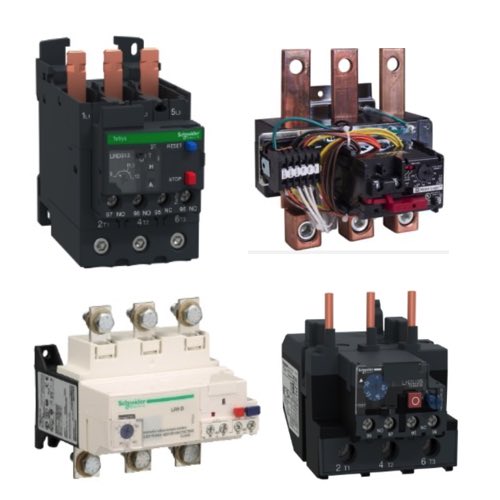Schneider Electric Starter Overload Relays

Schneider Electric's overload relays protect motors from excess current, overheating, and phase failures—conditions that can lead to serious motor damage and even a complete motor burnout. These are not just "fuses," which open when an overcurrent condition occurs. Schneider's overload relays are much smarter than that. They operate by measuring current and then opening the circuit to the motor if the current goes too high for too long. They are available in thermal and electronic versions. Both types offer the relay flexibility and a variety of protection settings.
Bimetallic elements respond to excess current, heat up, and trip a thermal overload relay to disconnect a circuit. The bimetallic relay is not as precise as the digital overload relay. The t1 element serves as a time delay. Schneider Electric's overload relays integrate easily with contactors and other motor control components to systemize and secure control and protection against excess current with a broad lineup of industrial applications.
Motor Control Basics
Motor control allows operational control of electrical motors in various environments.
Motor control circuits provide a safe way to operate electrical motors. Back when motor control circuits were in their infancy, it would have been common to see a simple disconnect switch that would be used to turn on and off a motor. Depending on the size of the motor and how much voltage was required, operating this disconnect would have been dangerous, with a very high possibility of arcing or electrocution. Not to mention that when the disconnect was actuated, the large amount of inrush current would have damaged the motor over time.
In today's motor control circuits, there are a few common pieces of hardware.
A circuit breaker is used to protect the motor and any hardware downstream. A contactor and an overload relay are connected together and function in tandem to allow for remote and safe operation of the motor. The contactor functions much like a relay, allowing for a smaller electrical circuit to remotely close the motor contacts, starting the motor. The overload relay is designed to protect the motor in the case of a prolonged overcurrent event. These two devices are wired in series, so that if the overload relay detects an overcurrent event, the contactor will open the motor contacts, shutting off power to the motor.
The other two most common types of motor control hardware are a soft starter and a Variable Frequency Drive (VFD).
Both of these devices function in a similar way to the motor circuit with some added functions. The soft starter is designed to reduce large inrush current to the motor upon startup. This “soft starting” of the motor will prolong its life and allow for safer operation. The VFD performs the soft start functions, but also allows for speed control of the motor. This speed control is critical in many different environments and has made VFDs one of the most common and safe to use motor control circuits today.

